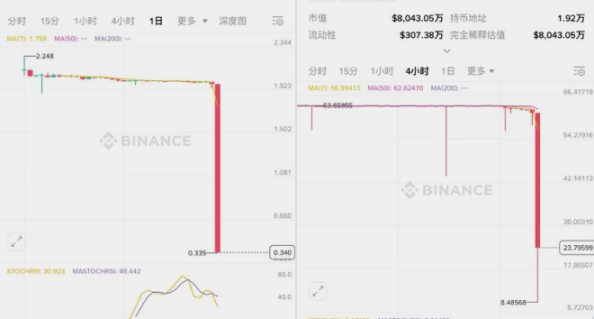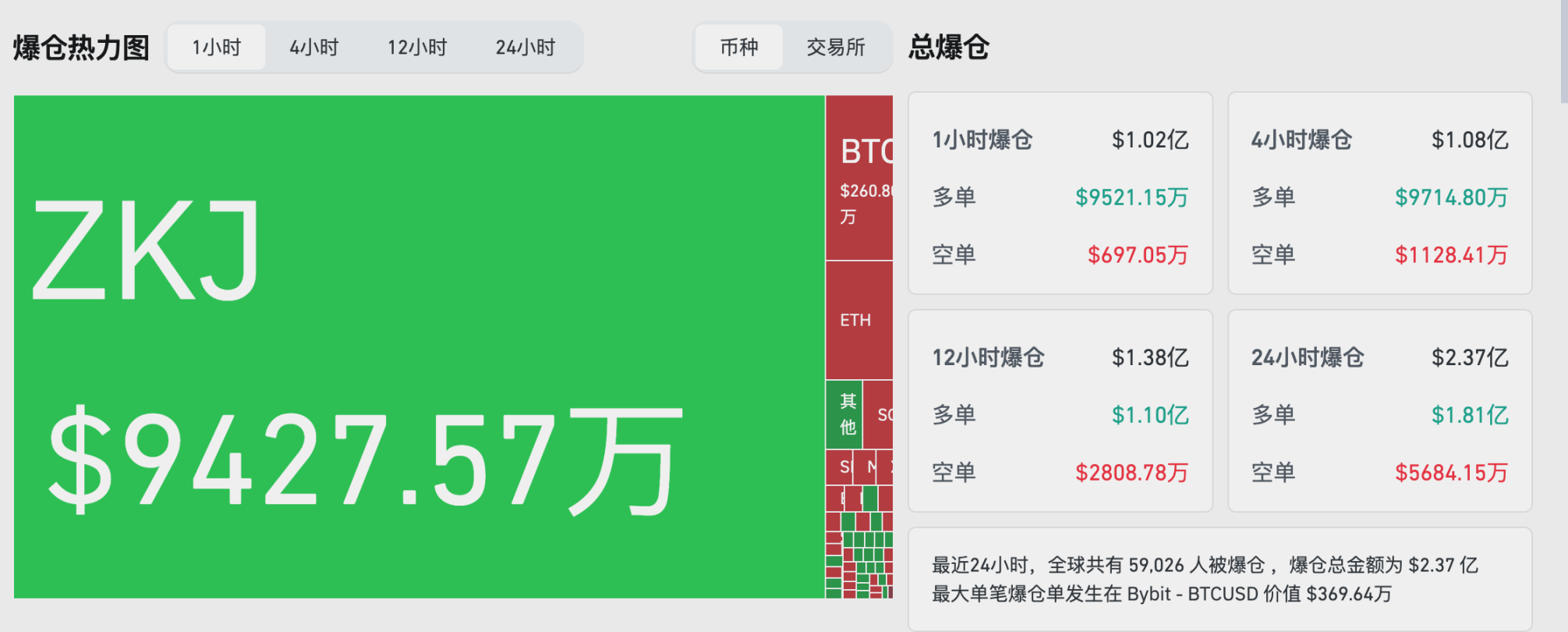Make small profits, suffer big losses.
Written by: angelilu, Foresight News
Players, please open your eyes, tonight ZKJ and KOGE have been poisoned!
In the calm ending of the weekend market, the crypto market once again staged a thrilling scene. On the evening of June 15, 2025, around 20:30, the two tokens with the largest trading volume on the BSC chain on the Binance Alpha platform, ZKJ and KOGE, experienced a cliff-like drop.
The token ZKJ from Polyhedra Network plummeted from $1.946, hitting a low of $0.3767 within just two hours, with a maximum drop of an astonishing 80.64%, and its market cap plummeted to only $230 million. Meanwhile, KOGE also dropped from $61 to a low of $8.46 within half an hour, with a similarly shocking decline.

Market Impact and Chain Reaction
Coinglass data shows that during the period from 20:00 to 22:00 that evening, the total liquidation amount across the network reached $102 million, with ZKJ alone contributing $94.336 million in liquidations, and long positions liquidated as high as $93.688 million, forming a typical bull trap.

For ordinary participants, the losses were particularly severe. Users who were merely trading to earn Binance Alpha points suffered devastating blows. For example, with an investment of $1,000, users who panic-sold during ZKJ's 80% drop lost an average of about $800, which is nearly the equivalent of the earnings from 10 Binance Alpha airdrops. Some users reported that their planned $5,000 investment to accumulate points through small trades was reduced to less than $500 after the flash crash, resulting in a net loss of $4,500. This once again confirms the saying, "Make small profits, suffer big losses."
It is worth noting that ZKJ's trading price had remained around a fully diluted valuation (FDV) of about $2 billion for the previous few months, showing an unusually stable trend—with liquidity exceeding $20 million, it was almost like a "stablecoin," and it had long held the top position in the Binance Alpha points ranking. This irrational price performance now appears to have been the calm before the storm.
Warning Signs Before the Crash
In fact, signs of a crash had already emerged the day before. The prices of ZKJ and KOGE experienced slight fluctuations yesterday, and analysts pointed out that the initial drop of ZKJ and KOGE stemmed from a specific address (starting with 0x364) withdrawing 1.29 million ZKJ and 8,667 KOGE from OKX, followed by a sell-off.
Market observers indicated that "the 3% fluctuation of KOGE and ZKJ yesterday was the countdown to the crash. Price fluctuation → fewer wash traders → APY plummets → LPs withdraw liquidity → spot market crashes → more people withdraw liquidity. When the negative spiral begins, it’s like an avalanche, unrelated to the quality of the project itself."
Even more surprising, the 48 Club team behind KOGE issued a statement indicating that "KOGE has been fully released since day one, with no lock-up. The 48 Club has never promised not to sell treasury holdings. Investors should do their own research and bear the risks." This statement was interpreted by many investors afterward as a disguised "warning of a crash."
In-Depth Analysis of the Underlying Causes
According to on-chain analyst AI Yi's research, the flash crash of ZKJ and KOGE exhibited characteristics of a meticulously planned harvesting operation. Three main addresses targeted the massive trading volume and liquidity generated by the two tokens under the Binance Alpha background, using a dual strategy of "large liquidity withdrawals + continuous sell-offs" to cause the two tokens to crash consecutively:
The address starting with 0x1A2 withdrew about $3.76 million in KOGE and $532,000 in ZKJ in two transactions between 20:28 and 20:33, then exchanged 45,470 KOGE for ZKJ worth $3.796 million, and sold off 1.573 million ZKJ in batches.
The second key address withdrew about $2.07 million in KOGE and $1.38 million in ZKJ liquidity while selling 1 million ZKJ.
The third address conducted a liquidation operation after receiving 772,000 ZKJ transferred from the second address, further exacerbating the downward trend of ZKJ.
It is noteworthy that the crypto community had previously popularized the strategy of "ZKJ-KOGE wash trading with low wear" during participation in Binance Alpha airdrop activities, which laid the groundwork for this harvesting operation.
AI Yi's in-depth analysis on the X platform revealed several key issues regarding this flash crash:
Strategic Considerations of the Dumping Order
The operators chose to dump KOGE first and then ZKJ, which was not a random selection. The primary reason is that ZKJ has contract trading, allowing operators to short on exchanges while simultaneously dumping on-chain, achieving dual profits. Secondly, from a liquidity perspective, ZKJ has relatively more liquidity, requiring more funds to dump, so it is more economical to start with the weaker liquidity of KOGE.
Mechanism of Delayed Price Crash
As well-known tokens in the Binance Alpha ecosystem for their "good liquidity + stable prices," ZKJ and KOGE led LPs (liquidity providers) to generally set extremely narrow price ranges. Once a large sell-off breaks through this narrow range, there is not enough capital in the market to absorb the sell orders, inevitably triggering a flash crash. More critically, when LPs see the price drop, they often panic and flee, further exacerbating the vicious cycle of price collapse. For those LPs who fail to react in time, the end result is passive holding of a large amount of devalued ZKJ and KOGE tokens.
Precision in Timing Selection
AI Yi speculated that the noticeable decline in trading volume on Binance Alpha for several consecutive days may have been a key inducement for the operators to choose this moment to dump. For large LPs, "running fast" is often a survival rule. Especially considering that there are few true long-term believers among the holders of ZKJ and KOGE, most participants are only in it for high interest, making the entire ecosystem extremely fragile, like a building that can collapse with the break of a single load-bearing pillar.
Moreover, analysts pointed out that 16 days before the incident, these two projects had jointly established a ZKJ/KOGE trading pair and liquidity pool on the Pancake platform, accumulating tokens worth $30 million. However, as altcoins in the Alpha ecosystem, once the price of one token crashes, it can easily trigger a chain sell-off of the other token, forming a "domino effect."
Additionally, on the news front, Polyhedra Network (ZKJ) plans to unlock about 15.53 million tokens at 8 AM on June 19, accounting for 5.04% of the current circulating supply, worth about $30.3 million. This impending unlocking pressure may also be one of the catalysts for the crash. Overall, this flash crash is the result of a combination of meticulously planned technical operations and objective pressures from the market fundamentals.
Reflection on the Binance Alpha Mechanism
This incident has also sparked profound reflections on the Binance Alpha points mechanism. Since Binance launched this mechanism, it has attracted a large number of users to participate in "farming" activities, but it has also provided opportunities for some ill-intentioned projects.
This flash crash coincided with the introduction of two reform measures in the Binance Alpha mechanism: first, the launch of the Alpha Wealth Management Center, allowing LP providers to earn points; second, the adjustment of the airdrop distribution mechanism, which will be distributed in two phases starting June 19, allowing users who meet the airdrop threshold to receive points first, and then the remaining points will be distributed. However, in this incident, holders, liquidity providers, and users attempting to earn points during the crash all suffered significant losses.
Market Warnings and Lessons
Within the community, traders had previously pointed out that so-called trading competitions often serve to help project parties offload their tokens. One user analyzed that before ZKJ was listed on Binance, there was a holding of up to 100 million tokens on BYBIT, equivalent to over $200 million, comparable to the holdings of the mainstream token SUI on Binance. In this crash, over $600,000 in positions were liquidated just from contracts.
A trader offered advice: "I advise everyone not to buy such altcoins because of the Binance trading competition; encountering a spike could lead to heavy losses. Profits often do not outweigh potential losses."
The ZKJ and KOGE crash event serves as a wake-up call for the Binance Alpha ecosystem and crypto market participants. In the high-risk crypto market, especially when facing altcoin projects with opaque governance structures and artificially maintained liquidity, investors must remain highly vigilant to avoid becoming targets of harvesting.
As large and small holders rush to exit, the future direction of Binance Alpha activities and the platform's response to such issues will become the focus of market attention.
免责声明:本文章仅代表作者个人观点,不代表本平台的立场和观点。本文章仅供信息分享,不构成对任何人的任何投资建议。用户与作者之间的任何争议,与本平台无关。如网页中刊载的文章或图片涉及侵权,请提供相关的权利证明和身份证明发送邮件到support@aicoin.com,本平台相关工作人员将会进行核查。




